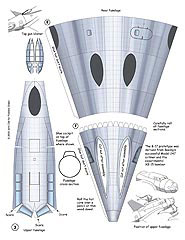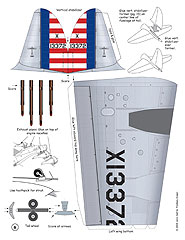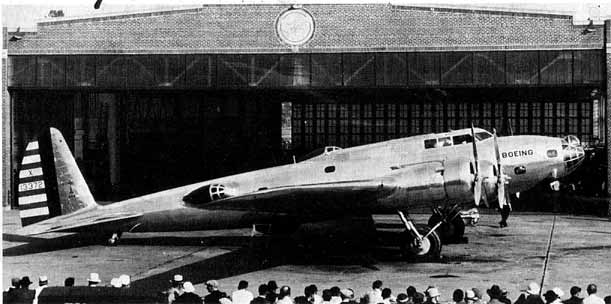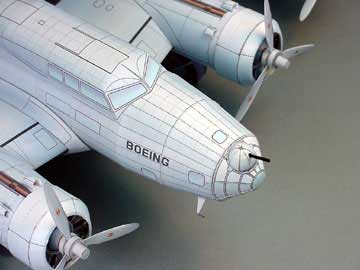



Boeing Model-299 - $$14.95
In 1937, the twelve Y1B-17s with the 2nd Bombardment Group at Langley Field represented the entire American fleet of Heavy Bombers. Notably, it was built with NOT ONE cent of Army money and Boeing was in difficult circumstances at the time. This noble effort led the way to the legendary WWII B-17 Flying Fortress that arguably won the war crippling the Nazi war machine.
Boeing Model-299 or XB-17 or Y1B-17 or YB-17


It is hard to appreciate the huge gamble that Boeing took with the Model 299 way back in the 1930s.
Notably, it wasn't built with a cent of Army money and, what's more, the company was in difficult circumstances at the time, When an invitation was received from the Army on August 8, 1934, to submit a company-owned design in a fly-off bomber design competition to be held at Wright Field in August, 1935, Boeing decided to enter.
Boeing had to determine that a four-engine design was acceptable under the rules, which specified a "multi-engine" design capable of carrying a 2000-lb. bomb load a desired distance of 2200 miles at a required top speed of 200 m.p.h. but a desired top speed of 250 m.p.h. A visit to Wright Field by Boeing President Claire Egtvedt brought official assurance that the term "multi-engine", then commonly applied to twin-engine designs, also included four engines. Using the extra power to carry the small load faster, Boeing plunged ahead with Model 299 and this is a model of the amazing result.
Gorgeous, gorgeous, gorgeous! Cal Grossmann
Once again a nice one for the hanger. Well done.TW
"Gorgeous, unbelievable, inspiration[al], tingly, stunning, top notch, beautiful, just too pretty, a big hit..."There remains no other worthy superlatives; just dumbfounded awe...Thank you, John
Holy Cow John! That is just too pretty. Should be a big hit at the convention. Wish I could make it. :-( You're workmanship is impeccable). Mike Smith
What a beautiful rendition of a beautiful plane. Jim Cookson
Boeing Model 299

On August 16, 1934, Boeing began construction of a four engine heavy bomber with which it hoped to win a twin engine competition for the U.S.A.A.F.'s new standard bearer. Financed by the company itself, the Boeing Model 299 lifted into the air on July 28, 1935, and led the way for one of the world's most famous series of airplanes.
This new design appeared as a scaled down version of the, as yet unfinished,
XB-15, since much of the latter's engineering principles had been applied
to the smaller craft. Performance of the 299 immediately overshadowed
that of its two engine competitors. The four Pratt & Whitney R-1690-E
Hornets, each offering 750 hp, provided a top speed of 250 mph and a
service ceiling of 25,000 feet. Among the new features incorporated
into the Model 299 were control locks designed to keep the wind from
buffeting the large moveable surfaces while on the ground. On October
30, 1935, during Air Corps tests, this innovation was tragically overlooked
and, after taking off with the controls locked, the 299 fell to its
destruction. 
But Boeing's gamble paid off when on January 17, 1936, thirteen planes were ordered. As the YB-17, the first Flying Fortress (A.F. serial number 36-149), was accepted in January, 1937. Power was supplied by Wright R-1820-39 Cyclones of 930 hp, and a 'top speed of 256 mph was achieved. Service ceiling was 30,600 feet. The maximum range was 3,320 miles. Five and a quarter tons of bombs could be carried 1,377 miles. The six crewmen were armed with five .30 or .50 cal. guns.
The YB-17 had an empty weight of 24,468 pounds and a gross of 34,873 pounds. The 103 foot 9 inch wing had an area of 1,420 square feet and remained basically unchanged in the subsequent models. One YB-17 was fitted with Wright R-1850-21 supercharged engines giving 1,000 hp on take-off and a speed of 295 mph at 25,000 feet. This was the sole YB-17A and was distinguished by the removal of the fairing's over the engine nacelles.
The Fortress design was subjected to many modifications in the never ending quest for improved performance. The original 68 foot 4 inch length of the YB-17 differed on some of the later models. The basic changes in the B-17B are as follows: removal of nose blister and bombardier's indentation, length reduced to 67 feet 11 inches, R-1820-51 engines, empty weight of 27,650 pounds, gross 37,810 pounds, fuel capacity 1,700 gallons, top speed of 291 mph, cruising speed 231 mph, service ceiling 36,000 feet, 8,000 pounds of bombs, armament of one .30 cal. and six .50 cal. guns. Thirty-nine B-17B's were built. The "D"'s had self-sealing fuel tanks.
 |
 |
 Hello
everyone, I've been getting started on the Boeing Model 299
model and I'd like to show what I have done so far. (Jan, 05) Hello
everyone, I've been getting started on the Boeing Model 299
model and I'd like to show what I have done so far. (Jan, 05) |
Chauncy designed the nice gun blisters
for me. And, I've already made some revisions to the tail surfaces.
There is also some more I'd like to do with the cockpit area.
All in all, it's going pretty smoothly. I'm shooting to have
this done by the convention in July which is also the 70th anniversary
of the first flight. This model will then be a part of a four
plane set featuring two Y1B-17's and the Y1B-17A turbo charger
test bed. Let me know who would be interested in doing a beta-build.
I'd appreciate any comments or suggestions. This is my favorite
airplane and I want to get it right. Thanks and take care, John |
 |
 |
 |
 These three images thanks to Swampfox !! |
 |
 |
 |
 |
 |
 |
Specifications for the Boeing Model 299(B-17)
 |
Length: 74 ft 4 in Wingspan: 103 ft 9 in Height: 19 ft 1 in Wing area: 1,420 ft² Empty weight: 36,135 lb Max takeoff weight: 65,500 lb Powerplant: 4× Wright R-1820-97 "Cyclone" turbosupercharged radial engines, 1,200 hp each Performance Maximum speed: 287 mph Cruise speed: 182 mph Range: 2,000 mi Service ceiling: 35,600 ft Rate of climb: 900 ft/min Wing loading: 38.0 lb/ft² |
 |
 |
| The crew forgot to disengage the airplane's "gust lock," a device that held the bomber's movable control surfaces in place while the plane was parked on the ground, and having taken off, the aircraft entered a steep climb, stalled, nosed over and crashed, killing Hill and Tower (other observers survived with injuries). |


